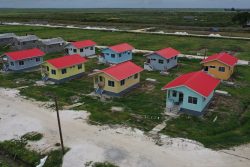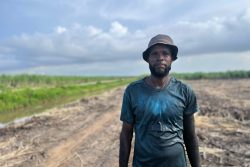As pressure continues to mount for answers on the death of 11-year-old Adriana Younge, the government yesterday announced that a retired expert from the Royal Canadian Mounted Police (RCMP) had been recruited for the investigation.
The Ministry of Home Affairs announced that as promised by President Irfaan Ali, the government had secured the services of a “distinguished” retired member of the RCMP, Leonard Mc Coshen, a trained and qualified homicide and suspicious death investigator to assist in the probe of the circumstances surrounding the death of Adriana.
Mc Coshen has over 30 years of experience as an investigator of the RCMP. He had spent 20 of those years attached to the Serious Crimes Branch (SCB) in the Major Crimes Unit (MCU), with the mandate to investigate serious, complex and sensitive matters, mainly homicides and deaths where foul play was suspected. The ministry in a release said that he has successfully supervised and coordinated over 200 homicides, kidnappings, and other serious and complex investigations.
In this regard, Mc Coshen brings a wealth of training, qualifications, and experience to the ongoing investigation into the death of Adriana.
Yesterday, there was no end in sight to the contention over the circumstances of the death and the planned funeral of the girl remains on hold after a sudden postponement on Monday.
The Guyana Police Force (GPF) also issued a statement yesterday setting out some of the findings in the preliminary autopsy report even as the final results of toxicological and other tests are awaited. The police said that the move was made in an effort to counter what it referred to a relentless campaign by some individuals to distort the truth particularly on social media, concerning the events and procedures surrounding the autopsy of the body of the 11-year-old discovered in the swimming pool of the Double Day Hotel in Tuschen, East Bank Essequibo, on Thursday, April 24.
The GPF noted that the Government of Guyana, in response to overwhelming public concerns about the circumstances in which the death had occurred, had taken the ‘extraordinary and unprecedented” steps to facilitate an independent forensic post mortem examination to be conducted by respected and highly qualified foreign pathologists.
Subsequently, Dr Gary Collins – specifically chosen by the family of the deceased, Dr Rudner from Mount Sinai, USA, and Dr Paul from the Government of Barbados, conducted a comprehensive forensic examination on the body of the deceased. This was conducted in the presence of Darren Wade, the legal representative of the family, and Dr Caleb McCloggan, a medical doctor chosen by the family.
The statement highlighted that it was the relatives of the deceased, their lawyer, and the doctor representing the family, who divulged to the press and published on social media, the preliminary finding of the cause of death – drowning – of the forensic examination.
As such, the GPF “categorically” rejects the contention of attorney-at-law Dexter Todd that the police, prematurely or at all, released the preliminary finding of the cause of death to the public. Moreover, it noted that it was never disputed that the report prepared by the pathologists was preliminary in nature, a fact that was made clear from the inception.
The statement viewed it as “unfortunate” that Todd would attempt to “blatantly mislead the public by his erroneous utterances and uninitiated opinions in a highly technical scientific field,” adding that professional comity and common courtesy demand that he defers to the opinion of three renowned international experts in the field.
Given what the statement describes as “a barrage of misinformation” being peddled in the social media intending to confuse and cause public mischief, the GPF highlighted the following findings of the preliminary forensic examination report: 1) There was no evidence of sexual assault (her external genitalia were examined and found unremarkable with her hymen intact); 2) Adriana’s soft tissues as well as skeletal structure were free of traumatic injury; 3) there was a residual cone of foam identified within her nostrils and oral cavity, which is often observed in cases of drowning (this finding dispels any contention that there was cotton wool in her nose); 4) the skin changes observed were from prolonged immersion with ‘washerwoman’ changes noted on bilateral hands and soles (washerwoman changes are also consistent in cases of drowning); 5) the skin was found to be intact and free from antemortem injuries (meaning that she did not receive any injuries to her body prior to her death); 6) the sphenoid sinus was found to have approximately one millilitre of liquid (this is the air space located in the brain consistent with drowning); 7) liquid also found in the lungs of the deceased, which is consistent with drowning.
Additionally, a comprehensive toxicological study of the blood and gastric contents is being conducted by the National Medical Services (NMS) Laboratories in the United States, and tissue specimens are undergoing histological analysis by Mount Sinai’s board-certified forensic and diagnostic pathologists in the United States.
According to the statement, the purpose of the post-mortem toxicology analysis is to detect, identify, and quantify drugs, alcohol, poisons, or other toxic substances present in the deceased’s body. This analysis helps determine whether any of these substances were present and, if so, whether they contributed to the death of the deceased.
The GPF expressed the hope that this statement has brought brings clarity to the matter, and advises against the dissemination of “malicious and unfounded rumors, fanciful and uneducated opinions, and reckless speculations” on this very grave and important matter.









